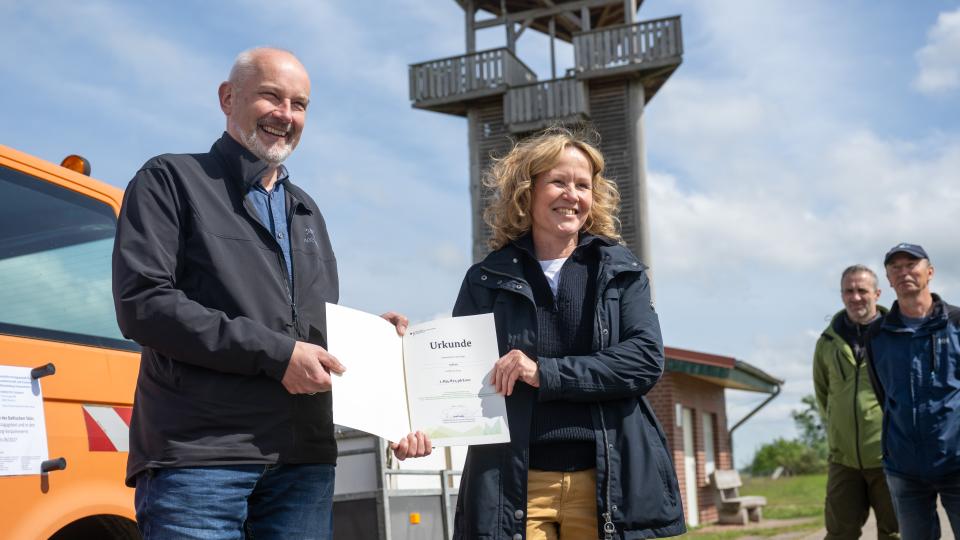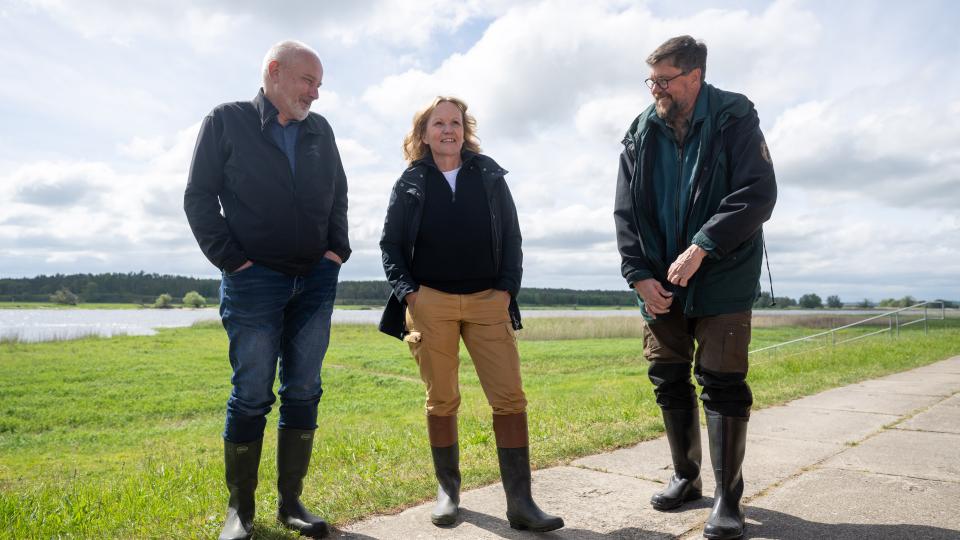
Every year, 50,000 to 100,000 of these young Baltic sturgeons are reared along the Oder and released into the river. From there, they migrate to the Baltic Sea and hopefully return to the river to spawn in a few years' time. Whether their journey is successful also depends on human help. | Photo: © Nadja Wohlleben Photography
Federal Minister for the Environment Steffi Lemke: "The Oder is a unique ecosystem that has been massively affected, not least by the environmental disaster in the summer of 2022. Restoration measures are still crucial to improve and protect this vulnerable ecosystem. The Oder is also the most suitable habitat to create a new future for the Baltic sturgeon, an impressive migratory fish that has disappeared from Europe. So not only do we support the reintroduction of the Baltic sturgeon, but restoration is also the best precautionary measure to make the Oder ecosystem more resilient to the effects of the climate crisis".
IGB researcher Dr Jörn Geßner: "In order for the sturgeons to find the conditions they need for successful reproduction, we need to set the right course now. This includes maintaining the availability of spawning and breeding grounds - such as gravel and sand banks and connected tributaries - in the Oder, and restoring them where necessary. This would not only benefit the sturgeon, but also many other typical fish species and river life.
National Park Director Dirk Treichel: "Here in the National Park we can see what a near-natural river with a typical, intact floodplain can look like. With its natural floodplains and strict protection status, the Lower Oder Valley National Park has been a special focus area since the start of the reintroduction project. Not only the sturgeon, but also the green damselfly, a dragonfly species, have their habitat here. It is therefore crucial to preserve these areas rather than jeopardise them by developing the river for navigation".
Since 2007, IGB and numerous project partners have released around 3.5 million juvenile Baltic sturgeon (Acipenser oxyrinchus) into the Oder. Today, another 600 fish have joined them. The aim is to reintroduce the once-extinct species to the river and the Baltic Sea.
The young migratory fish were hatched at the State Research Centre for Agriculture and Fisheries (LFA) in Mecklenburg-Western Pomerania and raised at stations on the Darß and on the edge of the Lower Oder Valley National Park near Angermünde. This will allow the fish to acclimatise to their new habitat and fluctuating environmental conditions. "The most variable rearing conditions possible ensure a high degree of adaptability, and the use of water from the river helps the animals to become familiar with their home river," explained Jörn Gessner.
After the stocking, the young sturgeons also cross the Szczecin Lagoon on their way to the Baltic Sea. The sturgeons' ability to survive in both fresh and salt water depends on their body size. This makes the lagoon an important part of the sturgeon's habitat, as there is a large supply of food, which allows the sturgeon to grow faster. It also allows them to slowly adapt to the increasing salinity that they will face in the Baltic Sea. Sturgeons migrate to the Baltic Sea when they are between one and three years old and do not return to their native rivers to spawn until they are between 14 and 16 years old.
New research project follows sturgeon in the lagoon
A new project called "HaffStör", funded by the German Federal Agency for Nature Conservation (BfN) and the German Federal Ministry for the Environment, Nature Conservation and Nuclear Safety (BMUV) over the next three years, will support the reintroduction efforts with a solid database: The rare fish will be equipped with transmitters in order to better understand when and along which routes they migrate into the Baltic Sea and when they return. The impact of sturgeon by-catch in gillnet fisheries in the lagoon will also be assessed, helping to develop fishing techniques that reduce by-catch.
Federal Environment Minister Steffi Lemke said: "The new "HaffStör" project is an important contribution to improving our knowledge of sturgeon ecology and supporting sustainable fishing. In this way, we can reconcile the protection of species with the use of natural resources. The fishermen themselves are important partners in this project, because nature conservation can only be successful in cooperation with local stakeholders."
However, analysing fish movements underwater is not easy: while terrestrial animals can be well tracked using GPS technology, there are no similar high-resolution methods for underwater use. GPS tracking fails below the water's surface. The researchers are therefore using acoustic telemetry with underwater hydrophones to record the sturgeon's migrations.
In addition to IGB, partners in the new project include the Institute of Fisheries of the State Research Centre for Agriculture and Fisheries of Mecklenburg-Western Pomerania (LFA), the University of Szczecin, the local fishing sector and the Polish Anglers' Association in West Pomerania, as well as German and Polish environmental organisations.
Restoration as crisis prevention
In the long term, more tributaries of the Oder should be connected to the river to create more diverse habitats and refuges, whose productivity and diversity should also have a positive impact on the main river. Water retention in the near-natural floodplains of the Oder is also important – not only as a water reservoir for the river and the surrounding landscape, but also as a natural flood protection.
Restoration is also the best crisis prevention. Overexploitation, the consequences of the climate crisis and construction measures not only cause river fish to lose their spawning grounds and habitats, but also the resilience of the entire river. This can be countered by significantly increasing the diversity of the river's structure and species communities, but not with purely technical solutions.
Further information on sturgeon and the reintroduction programme
Information on the reintroduction programme >
Stocking measures after the environmental disaster on the Oder >

© BMUV/Christophe Gateau

© BMUV/Christophe Gateau

© BMUV/Christophe Gateau

© BMUV/Christophe Gateau








